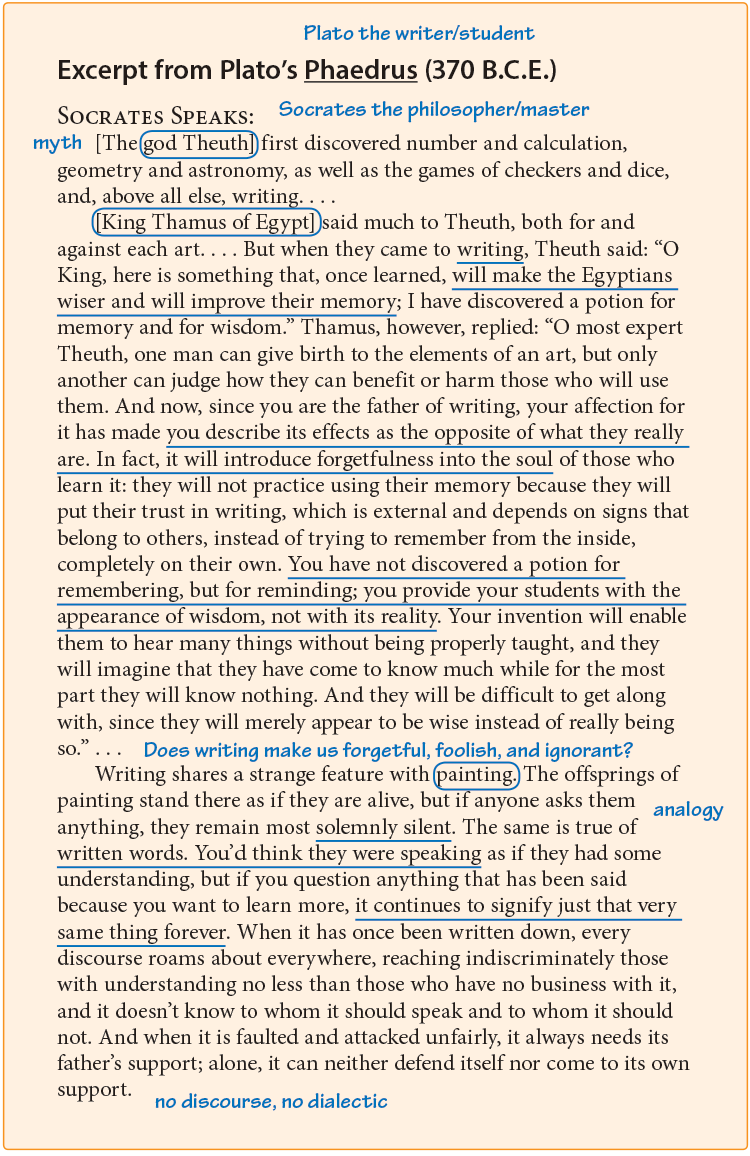Closely Reading Nonfiction
Close reading is active reading. Instead of simply skimming over a text, you engage it, question it, and think about it. Yes, you might start by looking at the heading, noting the source, and trying to get a sense of what you are about to read. But then you should read carefully, annotating the text as you go: underline important concepts, jot notes in the margin, and write questions that occur to you. After you finish reading, you should ask and answer the 5 W's and H about the topic, making sure you fully understand the reading.
You can practice this process by closely reading the following passage and answering questions about it.
Closely read an excerpt.
Read the following excerpt from Plato's Phaedrus, a dialogue in which the ancient Greek philosopher Socrates reflects on how writing changes people's thinking. First survey the piece, reading the heading and first sentences and getting a sense of what it is about. As you read, annotate the text, underlining key ideas and jotting down notes and questions. Afterward, answer the 5 W's and H about the reading. Make a copy of this Google doc or download a Word template.
Listen to "Excerpt from Plato's Phaedrus"
Hide audio
- Who wrote this piece, and who is featured as the narrator of the piece?
The philosopher Plato wrote the piece, and the philosopher Socrates is the narrator of it.
- What is the excerpt about?
The excerpt tells a story about the mythical creator of writing, who felt it would improve memory and create wisdom. Socrates argues that it does the exact opposite by making people rely on external symbols instead of internal memory.
- Where and when was this text originally written and read?
Plato wrote this work in 370 B.C.E., in ancient Greece.
- Why did the writer create this text? (What was he trying to do?)
(Answers will vary.) In the text, Socrates wanted to warn about writing and reading, that they can cause people to become lazy and forgetful, relying on words instead of memory. They have only the appearance of wisdom, but are instead foolish. However, Plato couldn't have really thought these things since he wrote the work. Obviously, the relationship between reading, writing, and thinking is more complicated than the text lets on.
- How does the writer make his point? What literary devices does he use?
Plato uses Socrates as his narrator. Socrates begins with a myth about the god who created writing, who speaks with the King of Egypt. The king argues that writing will make people forgetful, giving them the appearance of wisdom but not the reality. He then creates an analogy between paintings that can't speak or move and writing that always says the same thing.
- Do you agree or disagree with the excerpt? Why?
(Answers will vary.) Socrates creates an analogy about paintings, which remain "solemnly silent." However, this observation runs completely counter to the experience of people who have stood and studied a painting. The more the person looks at it, following the lines and colors, the more the painting "says" to him or her. It's the same with writing. The more carefully someone reads, the more questions the person asks, the more the text reveals. The problem with writing is when it is taken on face value as meaning only one thing for eternity. Readers that question and engage the text, creating a dialogue with it, don't have just the appearance of wisdom, but the reality.

